Champagne, Explained: A Snobbery-Free Guide to the Best of Bubbly
Five takeaways:
- Let’s start with the basics: champagne is a sparkling wine that bears the name of the region it comes from- the Champagne region of northeastern France.
- Champagnes are generally known for their bright acidity and light, lively body, often with a brioche-y and/or nutty quality thanks to required minimum aging on the lees, or dead yeast cells
- Champagne differs from other sparkling wines in its fermentation process. It’s second fermentation happens naturally, inside the bottle– a natural carbonic gas that cannot escape the sealed bottle naturally makes the wine sparkling.
- Champagne producers fall into two categories: Récoltant-Manipulant and Négociant-Manipulant.
- A Récoltant-Manipulant grower, independently makes his or her wines onsite under his or her own label using grapes grown on the house’s vineyards exclusively.
- A Négociant-Manipulant — such as Veuve Clicquot, Moët Chandon, and other big, well-known brand names — is defined as a group that buys outside grapes then produces the champagne on their premises. These make up most of the international market.
- Pinot Noir, Chardonnay, and Meunier are the most commonly used grapes in the production of champagne.
From Céline Bossart for Food & Wine
Read the whole story.
This site may contain links to articles or other information that may be contained on a third-party website. Advisory Services Network, LLC and MAP Strategic Wealth Advisors are not responsible for and do not control, adopt, or endorse any content contained on any third party website. The information and material contained in linked articles is of a general nature and is intended for educational purposes only. Links to articles do not constitute a recommendation or a solicitation or offer of the purchase or sale of securities.

